Corporate Accounting: Cash Flow Statements Analysis Report
VerifiedAdded on 2022/11/13
|19
|5225
|69
Report
AI Summary
This report presents a comprehensive analysis of corporate accounting, focusing on the relative information content of income statements and statements of cash flows. It examines why investors find both financial statements crucial for decision-making, highlighting their respective strengths in assessing a company's financial performance and position. The report delves into a comparative analysis of three companies' cash flow statements over a three-year period, evaluating their financial health and strength. It identifies the major sources and uses of cash for each firm, analyzes trends in cash flow from operations, and assesses their ability to cover capital expenses and dividends. Furthermore, the report explores how these companies generate and invest excess cash and concludes by determining the most financially sound company for lending purposes.
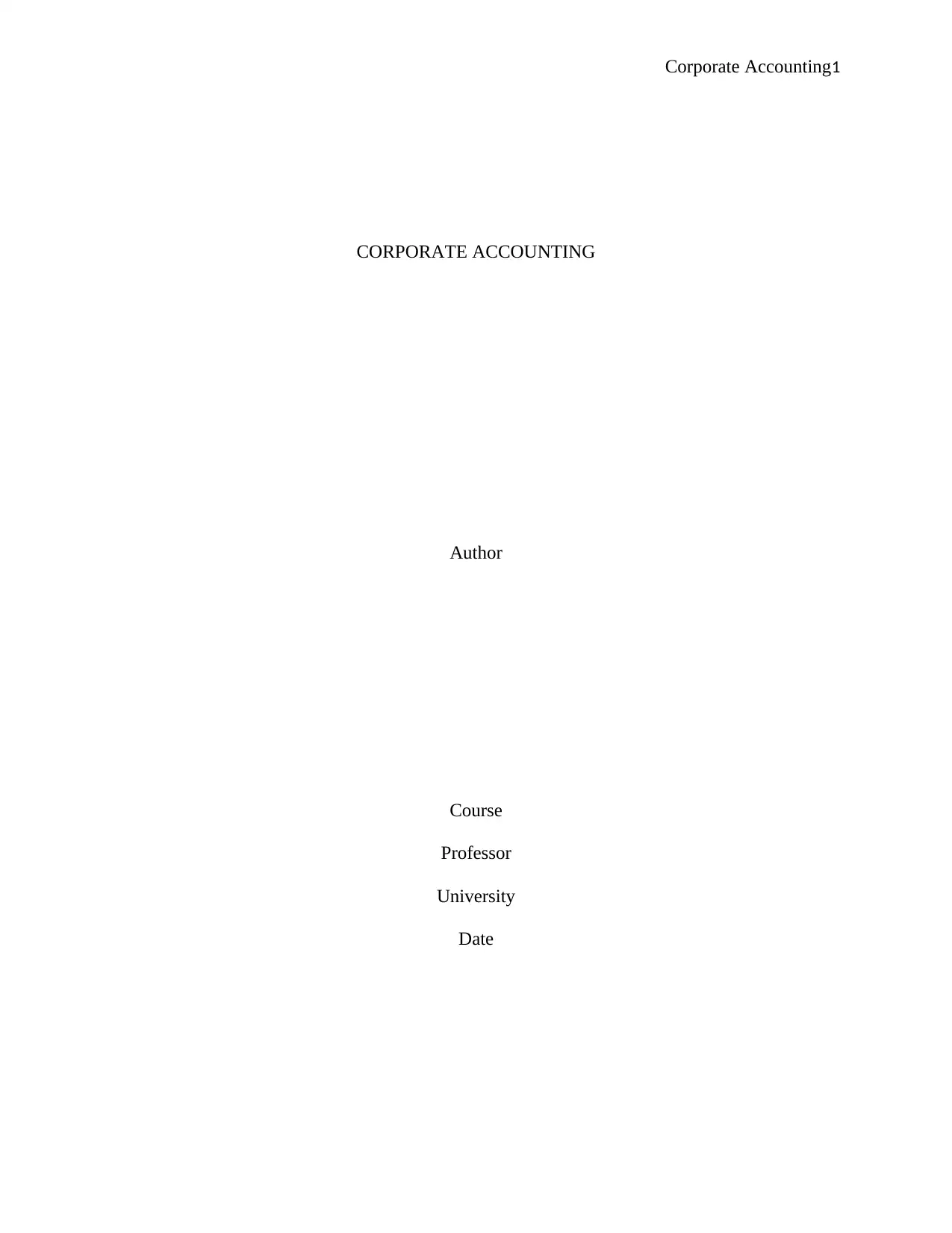
Corporate Accounting1
CORPORATE ACCOUNTING
Author
Course
Professor
University
Date
CORPORATE ACCOUNTING
Author
Course
Professor
University
Date
Paraphrase This Document
Need a fresh take? Get an instant paraphrase of this document with our AI Paraphraser
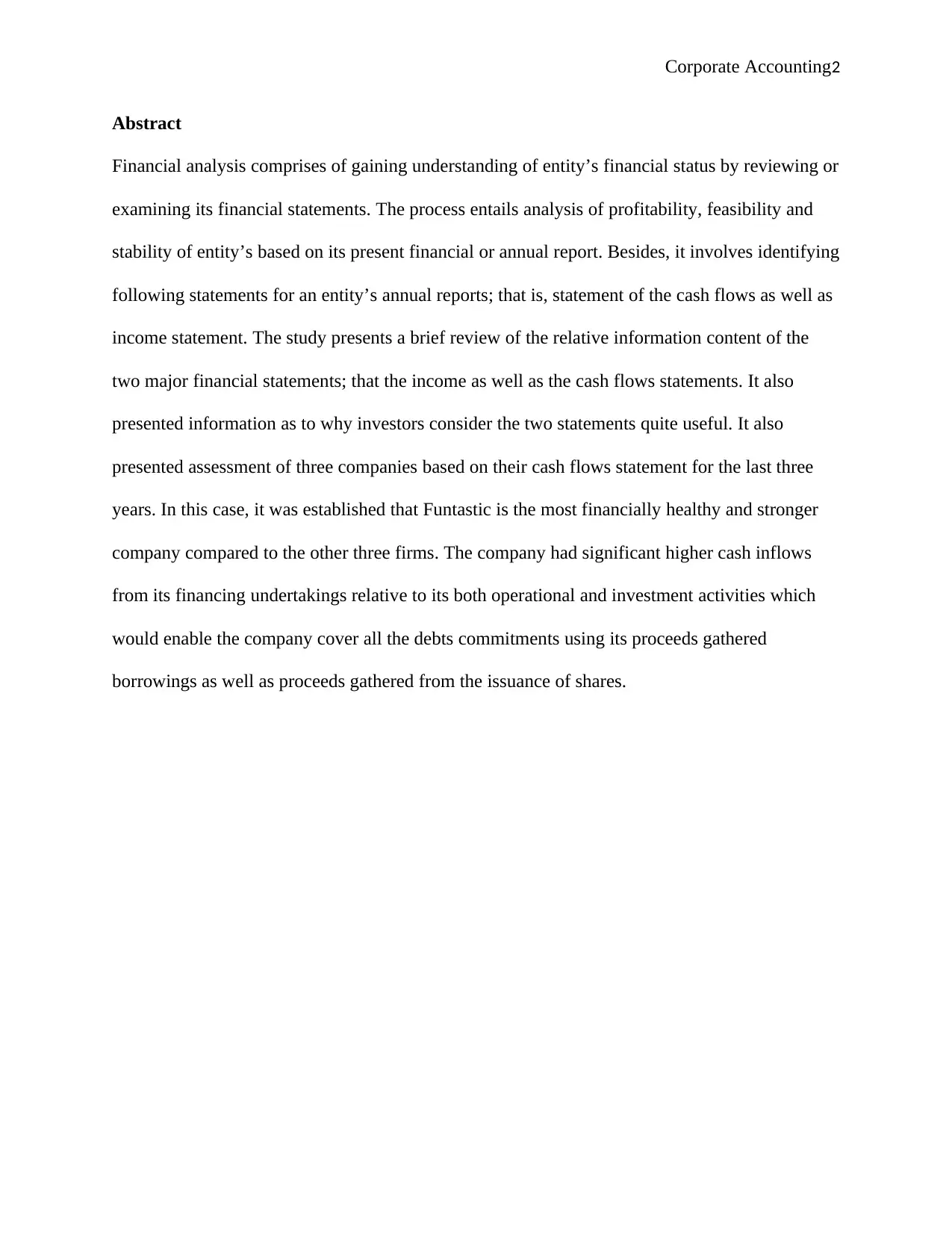
Corporate Accounting2
Abstract
Financial analysis comprises of gaining understanding of entity’s financial status by reviewing or
examining its financial statements. The process entails analysis of profitability, feasibility and
stability of entity’s based on its present financial or annual report. Besides, it involves identifying
following statements for an entity’s annual reports; that is, statement of the cash flows as well as
income statement. The study presents a brief review of the relative information content of the
two major financial statements; that the income as well as the cash flows statements. It also
presented information as to why investors consider the two statements quite useful. It also
presented assessment of three companies based on their cash flows statement for the last three
years. In this case, it was established that Funtastic is the most financially healthy and stronger
company compared to the other three firms. The company had significant higher cash inflows
from its financing undertakings relative to its both operational and investment activities which
would enable the company cover all the debts commitments using its proceeds gathered
borrowings as well as proceeds gathered from the issuance of shares.
Abstract
Financial analysis comprises of gaining understanding of entity’s financial status by reviewing or
examining its financial statements. The process entails analysis of profitability, feasibility and
stability of entity’s based on its present financial or annual report. Besides, it involves identifying
following statements for an entity’s annual reports; that is, statement of the cash flows as well as
income statement. The study presents a brief review of the relative information content of the
two major financial statements; that the income as well as the cash flows statements. It also
presented information as to why investors consider the two statements quite useful. It also
presented assessment of three companies based on their cash flows statement for the last three
years. In this case, it was established that Funtastic is the most financially healthy and stronger
company compared to the other three firms. The company had significant higher cash inflows
from its financing undertakings relative to its both operational and investment activities which
would enable the company cover all the debts commitments using its proceeds gathered
borrowings as well as proceeds gathered from the issuance of shares.
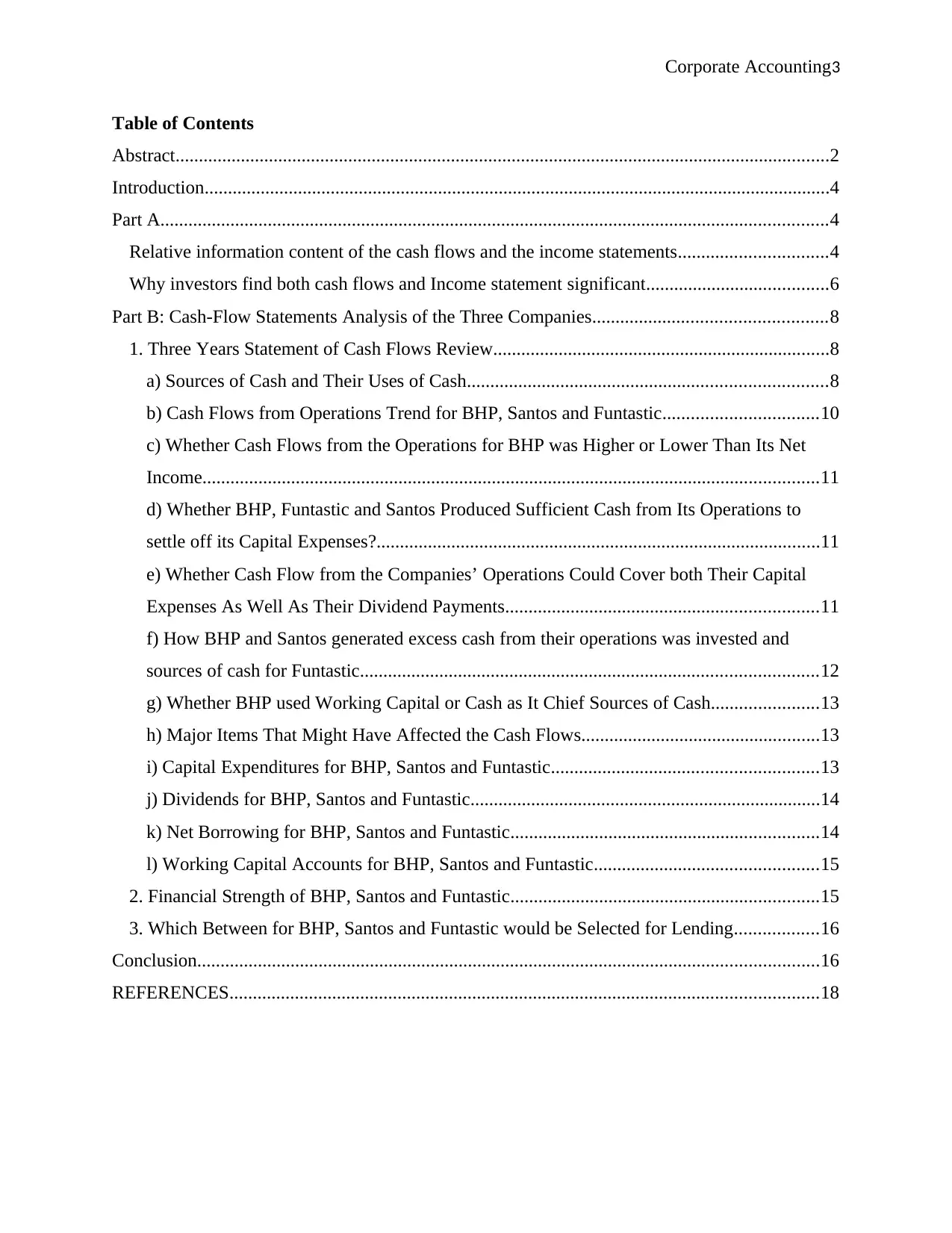
Corporate Accounting3
Table of Contents
Abstract............................................................................................................................................2
Introduction......................................................................................................................................4
Part A...............................................................................................................................................4
Relative information content of the cash flows and the income statements................................4
Why investors find both cash flows and Income statement significant.......................................6
Part B: Cash-Flow Statements Analysis of the Three Companies..................................................8
1. Three Years Statement of Cash Flows Review........................................................................8
a) Sources of Cash and Their Uses of Cash.............................................................................8
b) Cash Flows from Operations Trend for BHP, Santos and Funtastic.................................10
c) Whether Cash Flows from the Operations for BHP was Higher or Lower Than Its Net
Income....................................................................................................................................11
d) Whether BHP, Funtastic and Santos Produced Sufficient Cash from Its Operations to
settle off its Capital Expenses?...............................................................................................11
e) Whether Cash Flow from the Companies’ Operations Could Cover both Their Capital
Expenses As Well As Their Dividend Payments...................................................................11
f) How BHP and Santos generated excess cash from their operations was invested and
sources of cash for Funtastic..................................................................................................12
g) Whether BHP used Working Capital or Cash as It Chief Sources of Cash.......................13
h) Major Items That Might Have Affected the Cash Flows...................................................13
i) Capital Expenditures for BHP, Santos and Funtastic.........................................................13
j) Dividends for BHP, Santos and Funtastic...........................................................................14
k) Net Borrowing for BHP, Santos and Funtastic..................................................................14
l) Working Capital Accounts for BHP, Santos and Funtastic................................................15
2. Financial Strength of BHP, Santos and Funtastic..................................................................15
3. Which Between for BHP, Santos and Funtastic would be Selected for Lending..................16
Conclusion.....................................................................................................................................16
REFERENCES..............................................................................................................................18
Table of Contents
Abstract............................................................................................................................................2
Introduction......................................................................................................................................4
Part A...............................................................................................................................................4
Relative information content of the cash flows and the income statements................................4
Why investors find both cash flows and Income statement significant.......................................6
Part B: Cash-Flow Statements Analysis of the Three Companies..................................................8
1. Three Years Statement of Cash Flows Review........................................................................8
a) Sources of Cash and Their Uses of Cash.............................................................................8
b) Cash Flows from Operations Trend for BHP, Santos and Funtastic.................................10
c) Whether Cash Flows from the Operations for BHP was Higher or Lower Than Its Net
Income....................................................................................................................................11
d) Whether BHP, Funtastic and Santos Produced Sufficient Cash from Its Operations to
settle off its Capital Expenses?...............................................................................................11
e) Whether Cash Flow from the Companies’ Operations Could Cover both Their Capital
Expenses As Well As Their Dividend Payments...................................................................11
f) How BHP and Santos generated excess cash from their operations was invested and
sources of cash for Funtastic..................................................................................................12
g) Whether BHP used Working Capital or Cash as It Chief Sources of Cash.......................13
h) Major Items That Might Have Affected the Cash Flows...................................................13
i) Capital Expenditures for BHP, Santos and Funtastic.........................................................13
j) Dividends for BHP, Santos and Funtastic...........................................................................14
k) Net Borrowing for BHP, Santos and Funtastic..................................................................14
l) Working Capital Accounts for BHP, Santos and Funtastic................................................15
2. Financial Strength of BHP, Santos and Funtastic..................................................................15
3. Which Between for BHP, Santos and Funtastic would be Selected for Lending..................16
Conclusion.....................................................................................................................................16
REFERENCES..............................................................................................................................18
⊘ This is a preview!⊘
Do you want full access?
Subscribe today to unlock all pages.

Trusted by 1+ million students worldwide
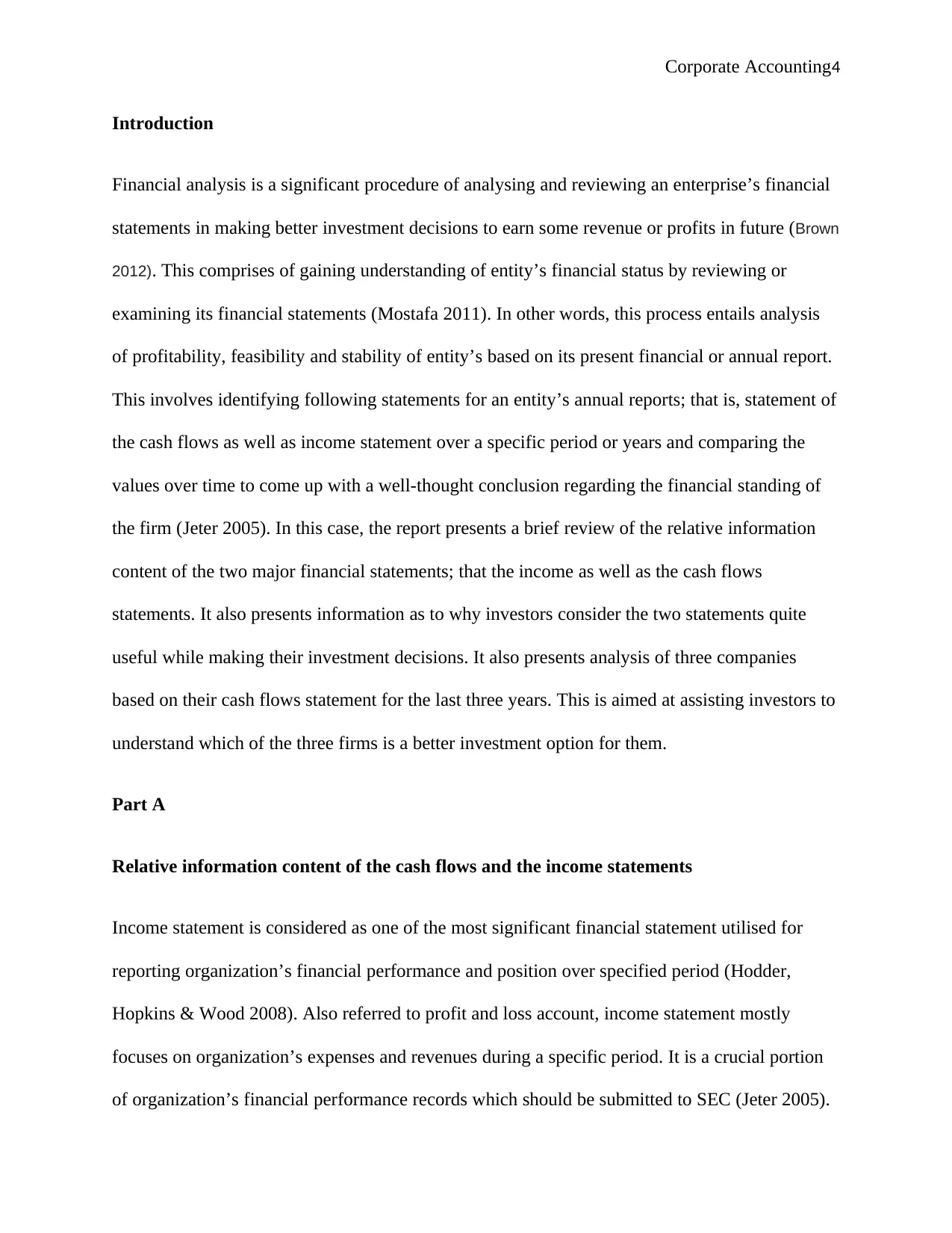
Corporate Accounting4
Introduction
Financial analysis is a significant procedure of analysing and reviewing an enterprise’s financial
statements in making better investment decisions to earn some revenue or profits in future (Brown
2012). This comprises of gaining understanding of entity’s financial status by reviewing or
examining its financial statements (Mostafa 2011). In other words, this process entails analysis
of profitability, feasibility and stability of entity’s based on its present financial or annual report.
This involves identifying following statements for an entity’s annual reports; that is, statement of
the cash flows as well as income statement over a specific period or years and comparing the
values over time to come up with a well-thought conclusion regarding the financial standing of
the firm (Jeter 2005). In this case, the report presents a brief review of the relative information
content of the two major financial statements; that the income as well as the cash flows
statements. It also presents information as to why investors consider the two statements quite
useful while making their investment decisions. It also presents analysis of three companies
based on their cash flows statement for the last three years. This is aimed at assisting investors to
understand which of the three firms is a better investment option for them.
Part A
Relative information content of the cash flows and the income statements
Income statement is considered as one of the most significant financial statement utilised for
reporting organization’s financial performance and position over specified period (Hodder,
Hopkins & Wood 2008). Also referred to profit and loss account, income statement mostly
focuses on organization’s expenses and revenues during a specific period. It is a crucial portion
of organization’s financial performance records which should be submitted to SEC (Jeter 2005).
Introduction
Financial analysis is a significant procedure of analysing and reviewing an enterprise’s financial
statements in making better investment decisions to earn some revenue or profits in future (Brown
2012). This comprises of gaining understanding of entity’s financial status by reviewing or
examining its financial statements (Mostafa 2011). In other words, this process entails analysis
of profitability, feasibility and stability of entity’s based on its present financial or annual report.
This involves identifying following statements for an entity’s annual reports; that is, statement of
the cash flows as well as income statement over a specific period or years and comparing the
values over time to come up with a well-thought conclusion regarding the financial standing of
the firm (Jeter 2005). In this case, the report presents a brief review of the relative information
content of the two major financial statements; that the income as well as the cash flows
statements. It also presents information as to why investors consider the two statements quite
useful while making their investment decisions. It also presents analysis of three companies
based on their cash flows statement for the last three years. This is aimed at assisting investors to
understand which of the three firms is a better investment option for them.
Part A
Relative information content of the cash flows and the income statements
Income statement is considered as one of the most significant financial statement utilised for
reporting organization’s financial performance and position over specified period (Hodder,
Hopkins & Wood 2008). Also referred to profit and loss account, income statement mostly
focuses on organization’s expenses and revenues during a specific period. It is a crucial portion
of organization’s financial performance records which should be submitted to SEC (Jeter 2005).
Paraphrase This Document
Need a fresh take? Get an instant paraphrase of this document with our AI Paraphraser
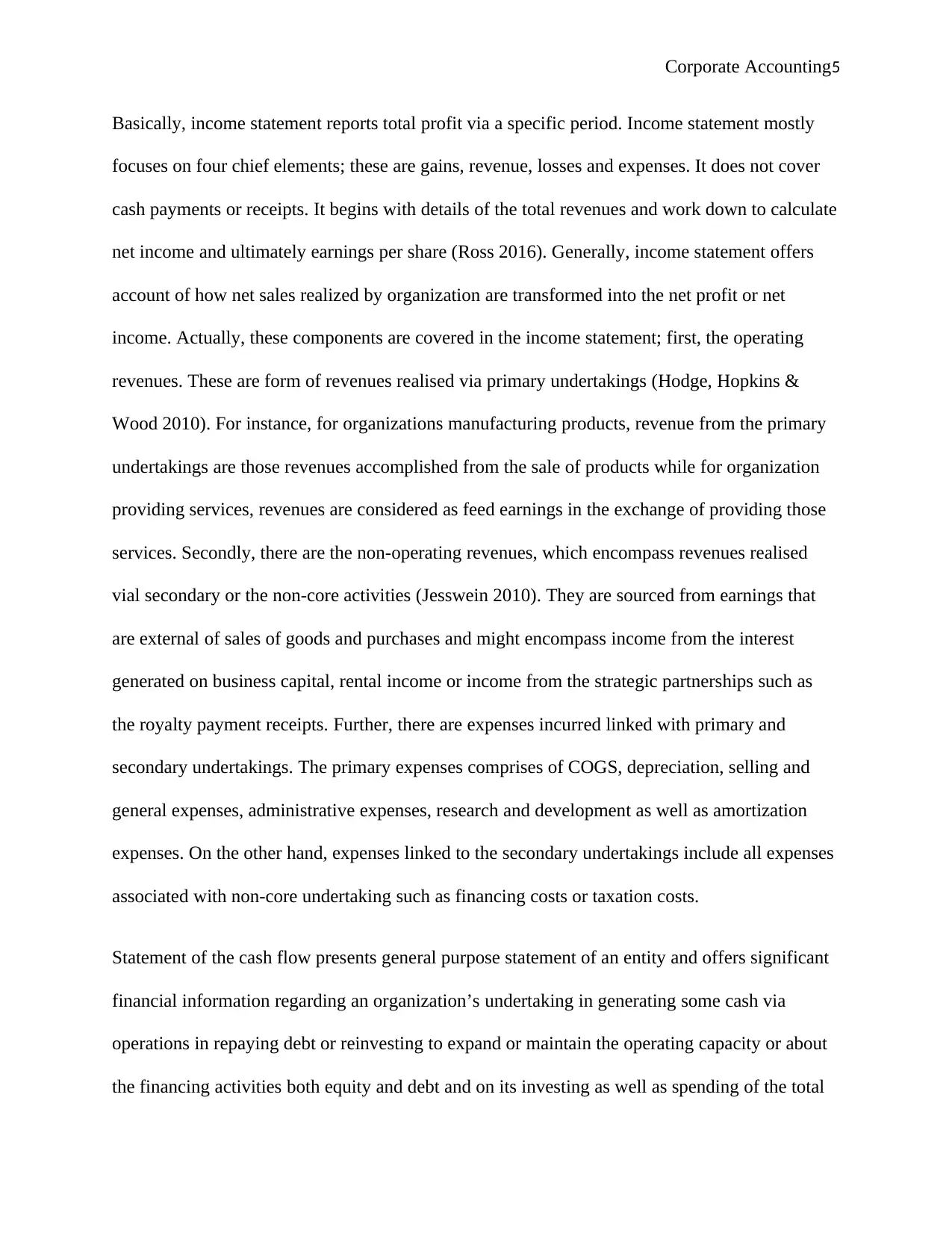
Corporate Accounting5
Basically, income statement reports total profit via a specific period. Income statement mostly
focuses on four chief elements; these are gains, revenue, losses and expenses. It does not cover
cash payments or receipts. It begins with details of the total revenues and work down to calculate
net income and ultimately earnings per share (Ross 2016). Generally, income statement offers
account of how net sales realized by organization are transformed into the net profit or net
income. Actually, these components are covered in the income statement; first, the operating
revenues. These are form of revenues realised via primary undertakings (Hodge, Hopkins &
Wood 2010). For instance, for organizations manufacturing products, revenue from the primary
undertakings are those revenues accomplished from the sale of products while for organization
providing services, revenues are considered as feed earnings in the exchange of providing those
services. Secondly, there are the non-operating revenues, which encompass revenues realised
vial secondary or the non-core activities (Jesswein 2010). They are sourced from earnings that
are external of sales of goods and purchases and might encompass income from the interest
generated on business capital, rental income or income from the strategic partnerships such as
the royalty payment receipts. Further, there are expenses incurred linked with primary and
secondary undertakings. The primary expenses comprises of COGS, depreciation, selling and
general expenses, administrative expenses, research and development as well as amortization
expenses. On the other hand, expenses linked to the secondary undertakings include all expenses
associated with non-core undertaking such as financing costs or taxation costs.
Statement of the cash flow presents general purpose statement of an entity and offers significant
financial information regarding an organization’s undertaking in generating some cash via
operations in repaying debt or reinvesting to expand or maintain the operating capacity or about
the financing activities both equity and debt and on its investing as well as spending of the total
Basically, income statement reports total profit via a specific period. Income statement mostly
focuses on four chief elements; these are gains, revenue, losses and expenses. It does not cover
cash payments or receipts. It begins with details of the total revenues and work down to calculate
net income and ultimately earnings per share (Ross 2016). Generally, income statement offers
account of how net sales realized by organization are transformed into the net profit or net
income. Actually, these components are covered in the income statement; first, the operating
revenues. These are form of revenues realised via primary undertakings (Hodge, Hopkins &
Wood 2010). For instance, for organizations manufacturing products, revenue from the primary
undertakings are those revenues accomplished from the sale of products while for organization
providing services, revenues are considered as feed earnings in the exchange of providing those
services. Secondly, there are the non-operating revenues, which encompass revenues realised
vial secondary or the non-core activities (Jesswein 2010). They are sourced from earnings that
are external of sales of goods and purchases and might encompass income from the interest
generated on business capital, rental income or income from the strategic partnerships such as
the royalty payment receipts. Further, there are expenses incurred linked with primary and
secondary undertakings. The primary expenses comprises of COGS, depreciation, selling and
general expenses, administrative expenses, research and development as well as amortization
expenses. On the other hand, expenses linked to the secondary undertakings include all expenses
associated with non-core undertaking such as financing costs or taxation costs.
Statement of the cash flow presents general purpose statement of an entity and offers significant
financial information regarding an organization’s undertaking in generating some cash via
operations in repaying debt or reinvesting to expand or maintain the operating capacity or about
the financing activities both equity and debt and on its investing as well as spending of the total
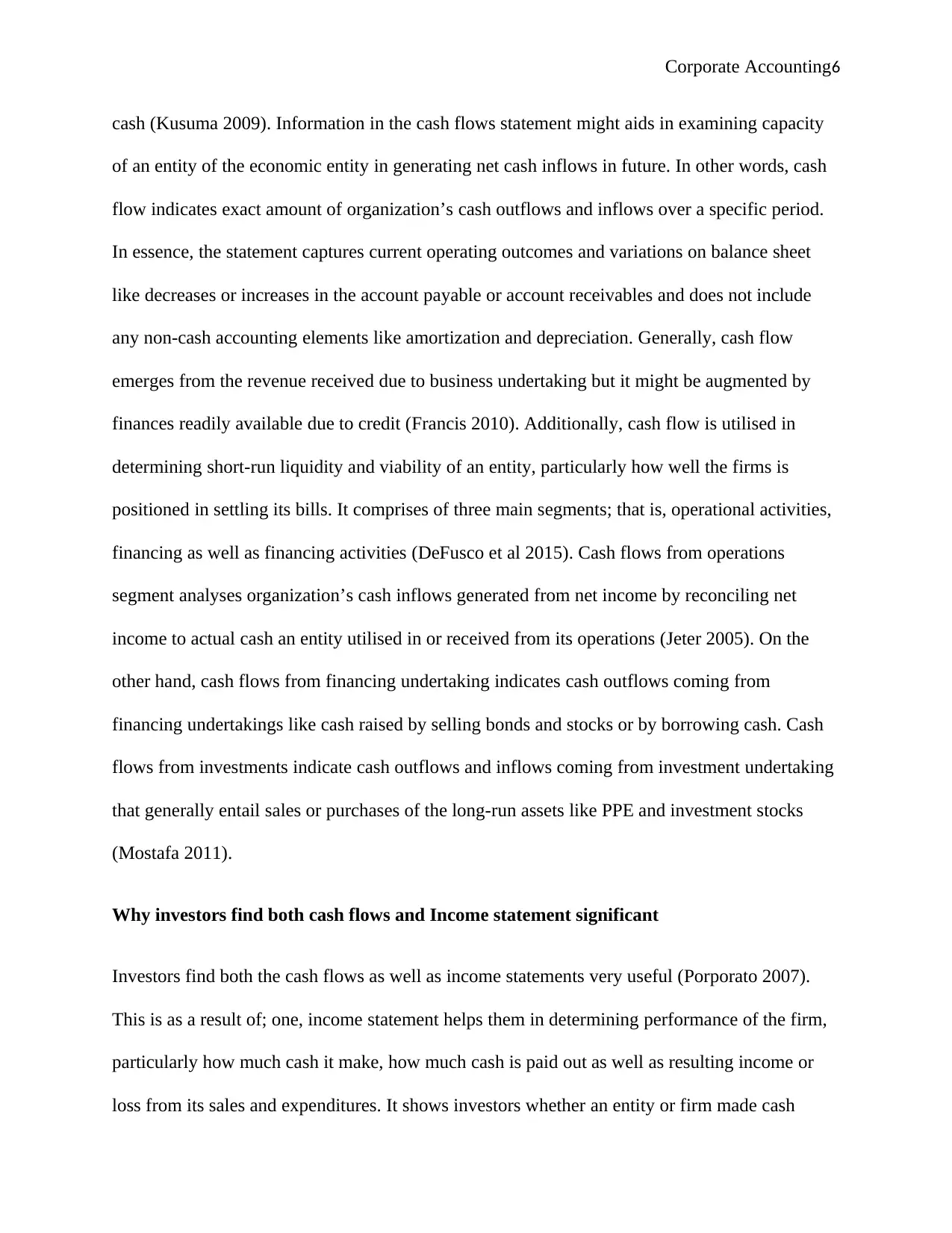
Corporate Accounting6
cash (Kusuma 2009). Information in the cash flows statement might aids in examining capacity
of an entity of the economic entity in generating net cash inflows in future. In other words, cash
flow indicates exact amount of organization’s cash outflows and inflows over a specific period.
In essence, the statement captures current operating outcomes and variations on balance sheet
like decreases or increases in the account payable or account receivables and does not include
any non-cash accounting elements like amortization and depreciation. Generally, cash flow
emerges from the revenue received due to business undertaking but it might be augmented by
finances readily available due to credit (Francis 2010). Additionally, cash flow is utilised in
determining short-run liquidity and viability of an entity, particularly how well the firms is
positioned in settling its bills. It comprises of three main segments; that is, operational activities,
financing as well as financing activities (DeFusco et al 2015). Cash flows from operations
segment analyses organization’s cash inflows generated from net income by reconciling net
income to actual cash an entity utilised in or received from its operations (Jeter 2005). On the
other hand, cash flows from financing undertaking indicates cash outflows coming from
financing undertakings like cash raised by selling bonds and stocks or by borrowing cash. Cash
flows from investments indicate cash outflows and inflows coming from investment undertaking
that generally entail sales or purchases of the long-run assets like PPE and investment stocks
(Mostafa 2011).
Why investors find both cash flows and Income statement significant
Investors find both the cash flows as well as income statements very useful (Porporato 2007).
This is as a result of; one, income statement helps them in determining performance of the firm,
particularly how much cash it make, how much cash is paid out as well as resulting income or
loss from its sales and expenditures. It shows investors whether an entity or firm made cash
cash (Kusuma 2009). Information in the cash flows statement might aids in examining capacity
of an entity of the economic entity in generating net cash inflows in future. In other words, cash
flow indicates exact amount of organization’s cash outflows and inflows over a specific period.
In essence, the statement captures current operating outcomes and variations on balance sheet
like decreases or increases in the account payable or account receivables and does not include
any non-cash accounting elements like amortization and depreciation. Generally, cash flow
emerges from the revenue received due to business undertaking but it might be augmented by
finances readily available due to credit (Francis 2010). Additionally, cash flow is utilised in
determining short-run liquidity and viability of an entity, particularly how well the firms is
positioned in settling its bills. It comprises of three main segments; that is, operational activities,
financing as well as financing activities (DeFusco et al 2015). Cash flows from operations
segment analyses organization’s cash inflows generated from net income by reconciling net
income to actual cash an entity utilised in or received from its operations (Jeter 2005). On the
other hand, cash flows from financing undertaking indicates cash outflows coming from
financing undertakings like cash raised by selling bonds and stocks or by borrowing cash. Cash
flows from investments indicate cash outflows and inflows coming from investment undertaking
that generally entail sales or purchases of the long-run assets like PPE and investment stocks
(Mostafa 2011).
Why investors find both cash flows and Income statement significant
Investors find both the cash flows as well as income statements very useful (Porporato 2007).
This is as a result of; one, income statement helps them in determining performance of the firm,
particularly how much cash it make, how much cash is paid out as well as resulting income or
loss from its sales and expenditures. It shows investors whether an entity or firm made cash
⊘ This is a preview!⊘
Do you want full access?
Subscribe today to unlock all pages.

Trusted by 1+ million students worldwide
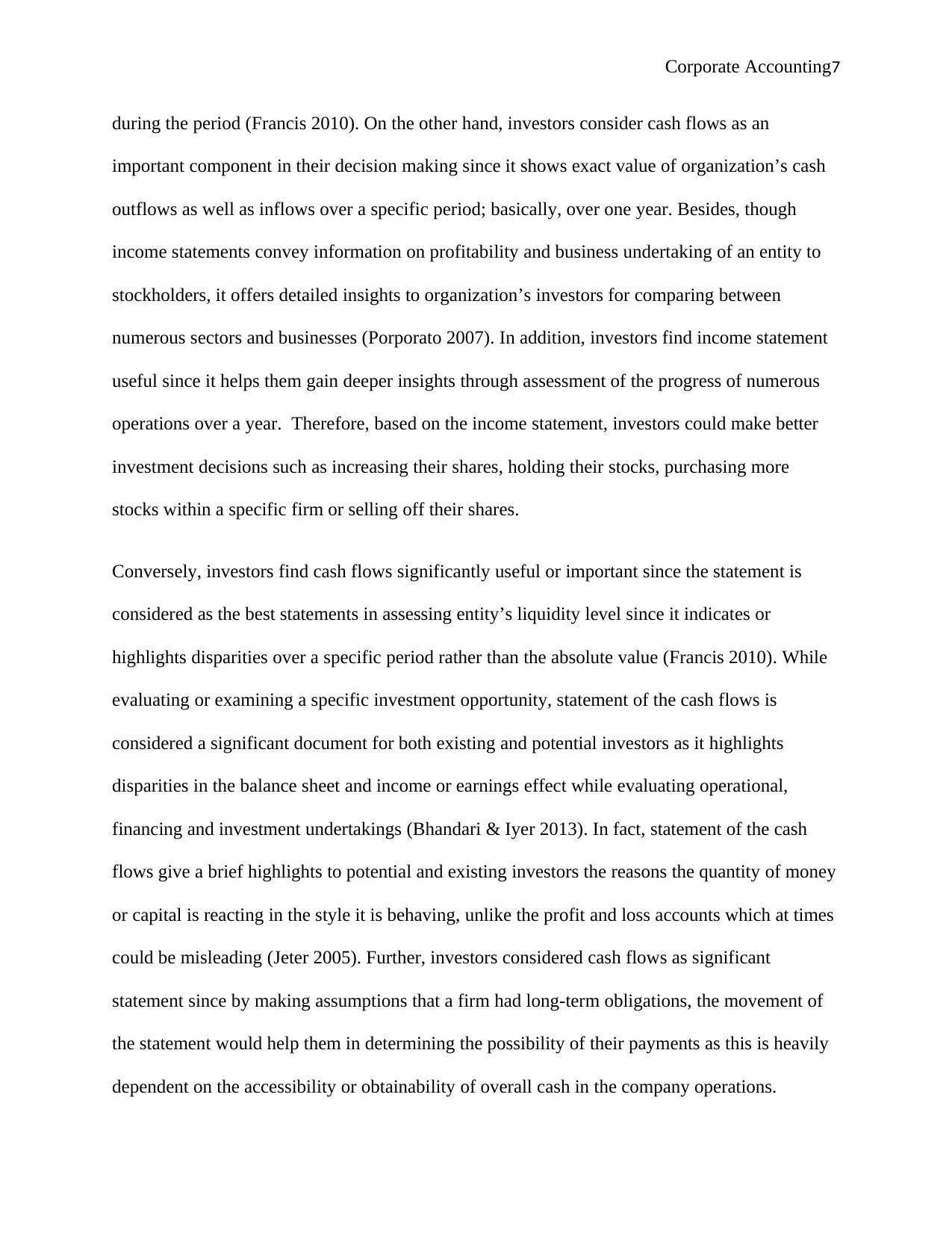
Corporate Accounting7
during the period (Francis 2010). On the other hand, investors consider cash flows as an
important component in their decision making since it shows exact value of organization’s cash
outflows as well as inflows over a specific period; basically, over one year. Besides, though
income statements convey information on profitability and business undertaking of an entity to
stockholders, it offers detailed insights to organization’s investors for comparing between
numerous sectors and businesses (Porporato 2007). In addition, investors find income statement
useful since it helps them gain deeper insights through assessment of the progress of numerous
operations over a year. Therefore, based on the income statement, investors could make better
investment decisions such as increasing their shares, holding their stocks, purchasing more
stocks within a specific firm or selling off their shares.
Conversely, investors find cash flows significantly useful or important since the statement is
considered as the best statements in assessing entity’s liquidity level since it indicates or
highlights disparities over a specific period rather than the absolute value (Francis 2010). While
evaluating or examining a specific investment opportunity, statement of the cash flows is
considered a significant document for both existing and potential investors as it highlights
disparities in the balance sheet and income or earnings effect while evaluating operational,
financing and investment undertakings (Bhandari & Iyer 2013). In fact, statement of the cash
flows give a brief highlights to potential and existing investors the reasons the quantity of money
or capital is reacting in the style it is behaving, unlike the profit and loss accounts which at times
could be misleading (Jeter 2005). Further, investors considered cash flows as significant
statement since by making assumptions that a firm had long-term obligations, the movement of
the statement would help them in determining the possibility of their payments as this is heavily
dependent on the accessibility or obtainability of overall cash in the company operations.
during the period (Francis 2010). On the other hand, investors consider cash flows as an
important component in their decision making since it shows exact value of organization’s cash
outflows as well as inflows over a specific period; basically, over one year. Besides, though
income statements convey information on profitability and business undertaking of an entity to
stockholders, it offers detailed insights to organization’s investors for comparing between
numerous sectors and businesses (Porporato 2007). In addition, investors find income statement
useful since it helps them gain deeper insights through assessment of the progress of numerous
operations over a year. Therefore, based on the income statement, investors could make better
investment decisions such as increasing their shares, holding their stocks, purchasing more
stocks within a specific firm or selling off their shares.
Conversely, investors find cash flows significantly useful or important since the statement is
considered as the best statements in assessing entity’s liquidity level since it indicates or
highlights disparities over a specific period rather than the absolute value (Francis 2010). While
evaluating or examining a specific investment opportunity, statement of the cash flows is
considered a significant document for both existing and potential investors as it highlights
disparities in the balance sheet and income or earnings effect while evaluating operational,
financing and investment undertakings (Bhandari & Iyer 2013). In fact, statement of the cash
flows give a brief highlights to potential and existing investors the reasons the quantity of money
or capital is reacting in the style it is behaving, unlike the profit and loss accounts which at times
could be misleading (Jeter 2005). Further, investors considered cash flows as significant
statement since by making assumptions that a firm had long-term obligations, the movement of
the statement would help them in determining the possibility of their payments as this is heavily
dependent on the accessibility or obtainability of overall cash in the company operations.
Paraphrase This Document
Need a fresh take? Get an instant paraphrase of this document with our AI Paraphraser
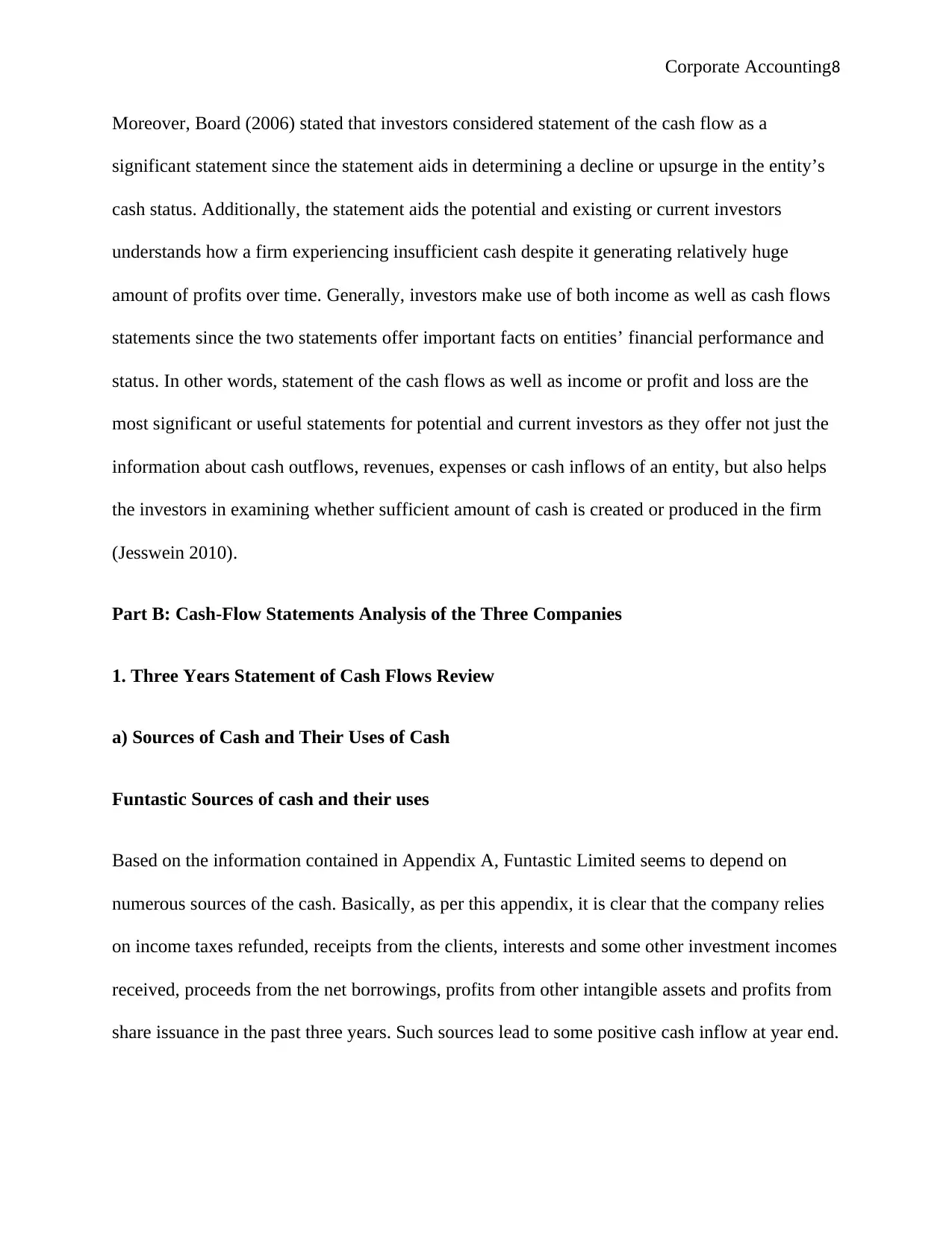
Corporate Accounting8
Moreover, Board (2006) stated that investors considered statement of the cash flow as a
significant statement since the statement aids in determining a decline or upsurge in the entity’s
cash status. Additionally, the statement aids the potential and existing or current investors
understands how a firm experiencing insufficient cash despite it generating relatively huge
amount of profits over time. Generally, investors make use of both income as well as cash flows
statements since the two statements offer important facts on entities’ financial performance and
status. In other words, statement of the cash flows as well as income or profit and loss are the
most significant or useful statements for potential and current investors as they offer not just the
information about cash outflows, revenues, expenses or cash inflows of an entity, but also helps
the investors in examining whether sufficient amount of cash is created or produced in the firm
(Jesswein 2010).
Part B: Cash-Flow Statements Analysis of the Three Companies
1. Three Years Statement of Cash Flows Review
a) Sources of Cash and Their Uses of Cash
Funtastic Sources of cash and their uses
Based on the information contained in Appendix A, Funtastic Limited seems to depend on
numerous sources of the cash. Basically, as per this appendix, it is clear that the company relies
on income taxes refunded, receipts from the clients, interests and some other investment incomes
received, proceeds from the net borrowings, profits from other intangible assets and profits from
share issuance in the past three years. Such sources lead to some positive cash inflow at year end.
Moreover, Board (2006) stated that investors considered statement of the cash flow as a
significant statement since the statement aids in determining a decline or upsurge in the entity’s
cash status. Additionally, the statement aids the potential and existing or current investors
understands how a firm experiencing insufficient cash despite it generating relatively huge
amount of profits over time. Generally, investors make use of both income as well as cash flows
statements since the two statements offer important facts on entities’ financial performance and
status. In other words, statement of the cash flows as well as income or profit and loss are the
most significant or useful statements for potential and current investors as they offer not just the
information about cash outflows, revenues, expenses or cash inflows of an entity, but also helps
the investors in examining whether sufficient amount of cash is created or produced in the firm
(Jesswein 2010).
Part B: Cash-Flow Statements Analysis of the Three Companies
1. Three Years Statement of Cash Flows Review
a) Sources of Cash and Their Uses of Cash
Funtastic Sources of cash and their uses
Based on the information contained in Appendix A, Funtastic Limited seems to depend on
numerous sources of the cash. Basically, as per this appendix, it is clear that the company relies
on income taxes refunded, receipts from the clients, interests and some other investment incomes
received, proceeds from the net borrowings, profits from other intangible assets and profits from
share issuance in the past three years. Such sources lead to some positive cash inflow at year end.
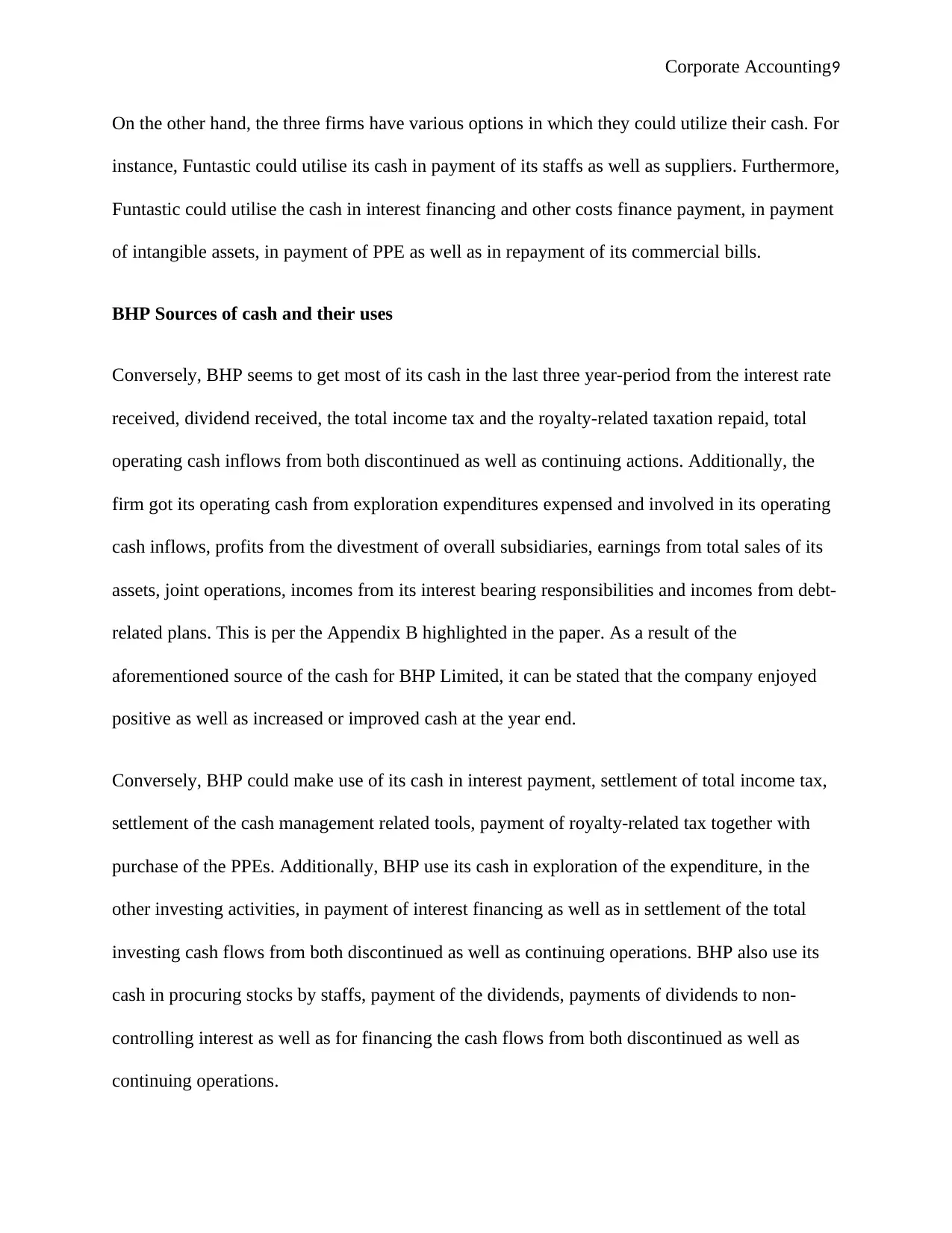
Corporate Accounting9
On the other hand, the three firms have various options in which they could utilize their cash. For
instance, Funtastic could utilise its cash in payment of its staffs as well as suppliers. Furthermore,
Funtastic could utilise the cash in interest financing and other costs finance payment, in payment
of intangible assets, in payment of PPE as well as in repayment of its commercial bills.
BHP Sources of cash and their uses
Conversely, BHP seems to get most of its cash in the last three year-period from the interest rate
received, dividend received, the total income tax and the royalty-related taxation repaid, total
operating cash inflows from both discontinued as well as continuing actions. Additionally, the
firm got its operating cash from exploration expenditures expensed and involved in its operating
cash inflows, profits from the divestment of overall subsidiaries, earnings from total sales of its
assets, joint operations, incomes from its interest bearing responsibilities and incomes from debt-
related plans. This is per the Appendix B highlighted in the paper. As a result of the
aforementioned source of the cash for BHP Limited, it can be stated that the company enjoyed
positive as well as increased or improved cash at the year end.
Conversely, BHP could make use of its cash in interest payment, settlement of total income tax,
settlement of the cash management related tools, payment of royalty-related tax together with
purchase of the PPEs. Additionally, BHP use its cash in exploration of the expenditure, in the
other investing activities, in payment of interest financing as well as in settlement of the total
investing cash flows from both discontinued as well as continuing operations. BHP also use its
cash in procuring stocks by staffs, payment of the dividends, payments of dividends to non-
controlling interest as well as for financing the cash flows from both discontinued as well as
continuing operations.
On the other hand, the three firms have various options in which they could utilize their cash. For
instance, Funtastic could utilise its cash in payment of its staffs as well as suppliers. Furthermore,
Funtastic could utilise the cash in interest financing and other costs finance payment, in payment
of intangible assets, in payment of PPE as well as in repayment of its commercial bills.
BHP Sources of cash and their uses
Conversely, BHP seems to get most of its cash in the last three year-period from the interest rate
received, dividend received, the total income tax and the royalty-related taxation repaid, total
operating cash inflows from both discontinued as well as continuing actions. Additionally, the
firm got its operating cash from exploration expenditures expensed and involved in its operating
cash inflows, profits from the divestment of overall subsidiaries, earnings from total sales of its
assets, joint operations, incomes from its interest bearing responsibilities and incomes from debt-
related plans. This is per the Appendix B highlighted in the paper. As a result of the
aforementioned source of the cash for BHP Limited, it can be stated that the company enjoyed
positive as well as increased or improved cash at the year end.
Conversely, BHP could make use of its cash in interest payment, settlement of total income tax,
settlement of the cash management related tools, payment of royalty-related tax together with
purchase of the PPEs. Additionally, BHP use its cash in exploration of the expenditure, in the
other investing activities, in payment of interest financing as well as in settlement of the total
investing cash flows from both discontinued as well as continuing operations. BHP also use its
cash in procuring stocks by staffs, payment of the dividends, payments of dividends to non-
controlling interest as well as for financing the cash flows from both discontinued as well as
continuing operations.
⊘ This is a preview!⊘
Do you want full access?
Subscribe today to unlock all pages.

Trusted by 1+ million students worldwide
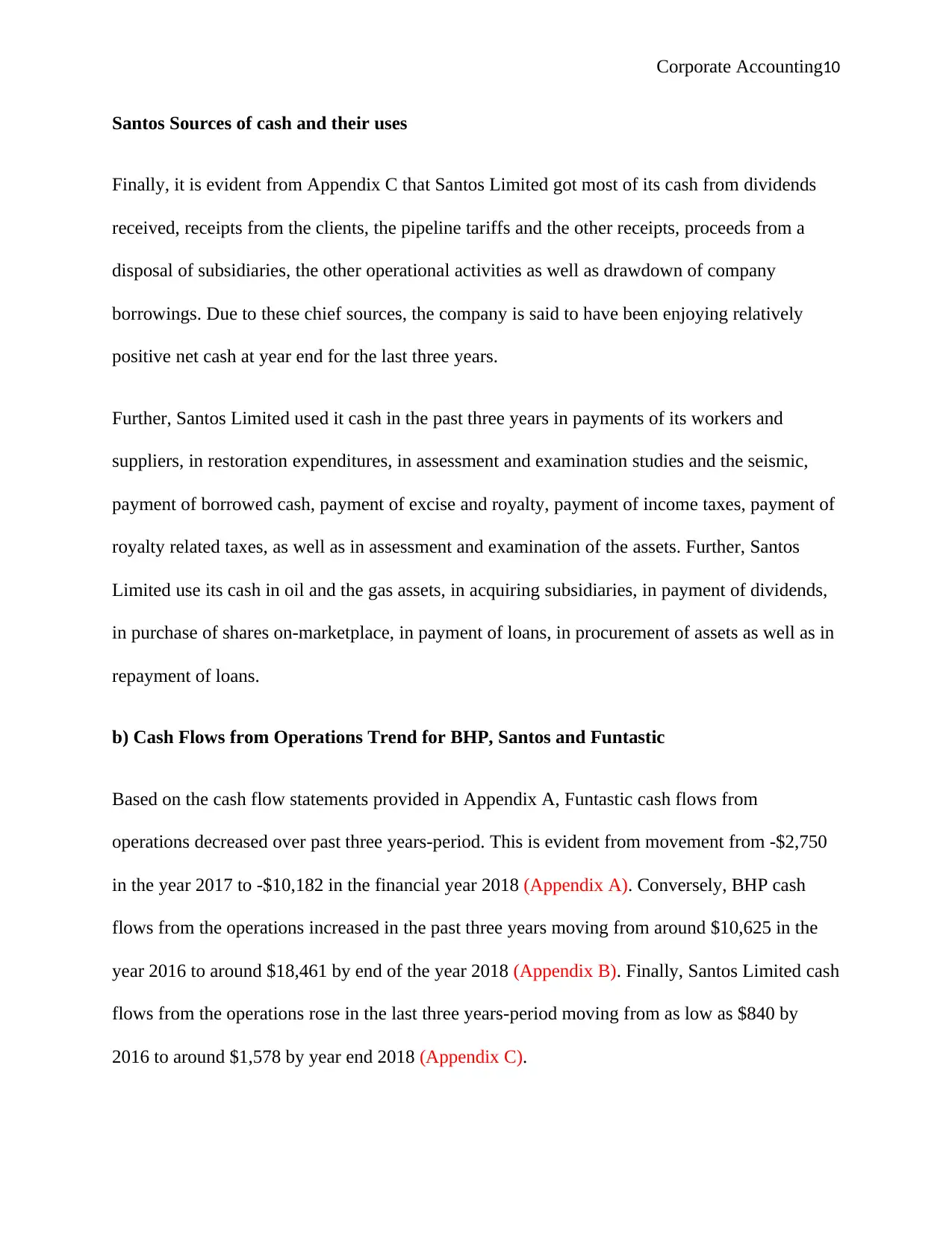
Corporate Accounting10
Santos Sources of cash and their uses
Finally, it is evident from Appendix C that Santos Limited got most of its cash from dividends
received, receipts from the clients, the pipeline tariffs and the other receipts, proceeds from a
disposal of subsidiaries, the other operational activities as well as drawdown of company
borrowings. Due to these chief sources, the company is said to have been enjoying relatively
positive net cash at year end for the last three years.
Further, Santos Limited used it cash in the past three years in payments of its workers and
suppliers, in restoration expenditures, in assessment and examination studies and the seismic,
payment of borrowed cash, payment of excise and royalty, payment of income taxes, payment of
royalty related taxes, as well as in assessment and examination of the assets. Further, Santos
Limited use its cash in oil and the gas assets, in acquiring subsidiaries, in payment of dividends,
in purchase of shares on-marketplace, in payment of loans, in procurement of assets as well as in
repayment of loans.
b) Cash Flows from Operations Trend for BHP, Santos and Funtastic
Based on the cash flow statements provided in Appendix A, Funtastic cash flows from
operations decreased over past three years-period. This is evident from movement from -$2,750
in the year 2017 to -$10,182 in the financial year 2018 (Appendix A). Conversely, BHP cash
flows from the operations increased in the past three years moving from around $10,625 in the
year 2016 to around $18,461 by end of the year 2018 (Appendix B). Finally, Santos Limited cash
flows from the operations rose in the last three years-period moving from as low as $840 by
2016 to around $1,578 by year end 2018 (Appendix C).
Santos Sources of cash and their uses
Finally, it is evident from Appendix C that Santos Limited got most of its cash from dividends
received, receipts from the clients, the pipeline tariffs and the other receipts, proceeds from a
disposal of subsidiaries, the other operational activities as well as drawdown of company
borrowings. Due to these chief sources, the company is said to have been enjoying relatively
positive net cash at year end for the last three years.
Further, Santos Limited used it cash in the past three years in payments of its workers and
suppliers, in restoration expenditures, in assessment and examination studies and the seismic,
payment of borrowed cash, payment of excise and royalty, payment of income taxes, payment of
royalty related taxes, as well as in assessment and examination of the assets. Further, Santos
Limited use its cash in oil and the gas assets, in acquiring subsidiaries, in payment of dividends,
in purchase of shares on-marketplace, in payment of loans, in procurement of assets as well as in
repayment of loans.
b) Cash Flows from Operations Trend for BHP, Santos and Funtastic
Based on the cash flow statements provided in Appendix A, Funtastic cash flows from
operations decreased over past three years-period. This is evident from movement from -$2,750
in the year 2017 to -$10,182 in the financial year 2018 (Appendix A). Conversely, BHP cash
flows from the operations increased in the past three years moving from around $10,625 in the
year 2016 to around $18,461 by end of the year 2018 (Appendix B). Finally, Santos Limited cash
flows from the operations rose in the last three years-period moving from as low as $840 by
2016 to around $1,578 by year end 2018 (Appendix C).
Paraphrase This Document
Need a fresh take? Get an instant paraphrase of this document with our AI Paraphraser
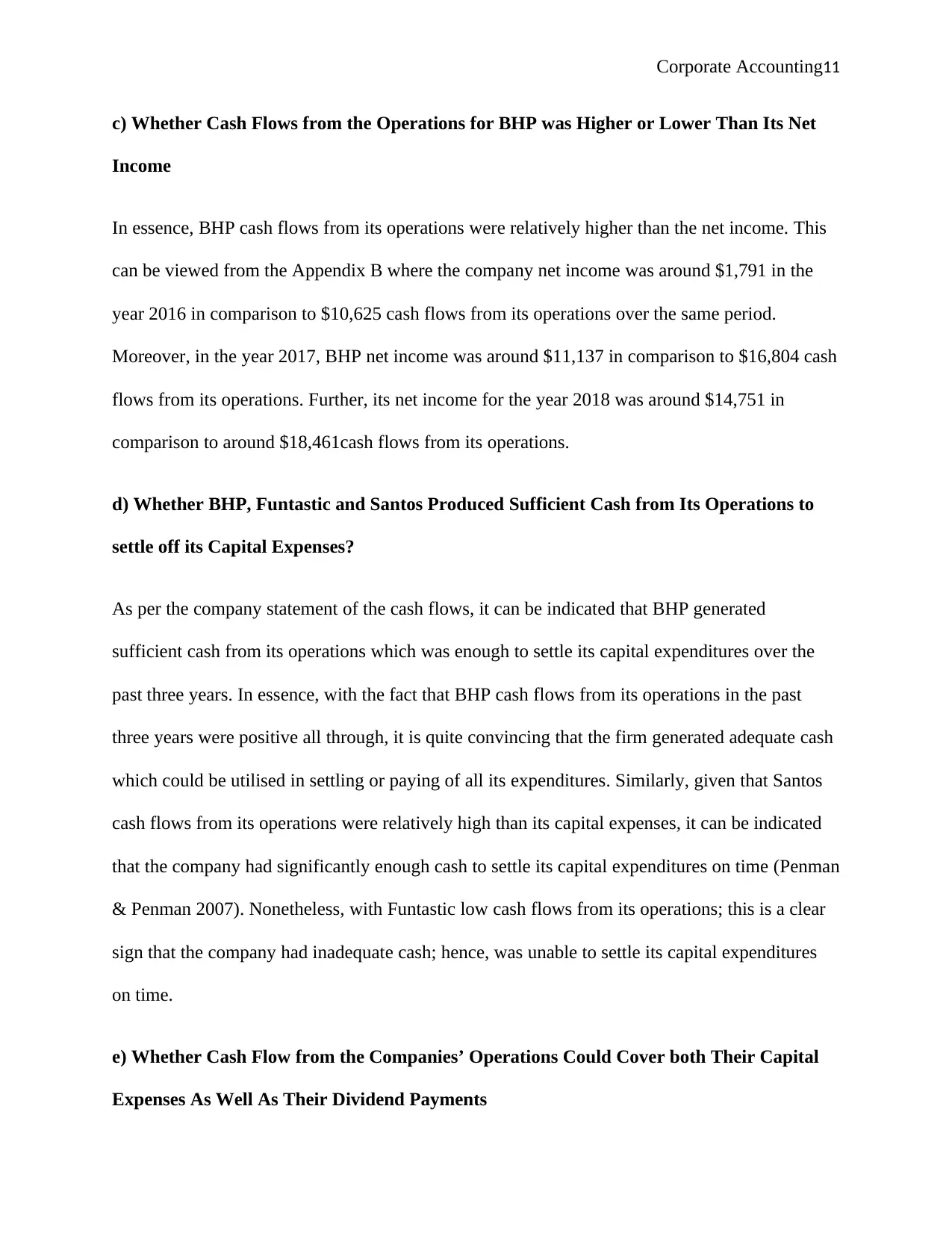
Corporate Accounting11
c) Whether Cash Flows from the Operations for BHP was Higher or Lower Than Its Net
Income
In essence, BHP cash flows from its operations were relatively higher than the net income. This
can be viewed from the Appendix B where the company net income was around $1,791 in the
year 2016 in comparison to $10,625 cash flows from its operations over the same period.
Moreover, in the year 2017, BHP net income was around $11,137 in comparison to $16,804 cash
flows from its operations. Further, its net income for the year 2018 was around $14,751 in
comparison to around $18,461cash flows from its operations.
d) Whether BHP, Funtastic and Santos Produced Sufficient Cash from Its Operations to
settle off its Capital Expenses?
As per the company statement of the cash flows, it can be indicated that BHP generated
sufficient cash from its operations which was enough to settle its capital expenditures over the
past three years. In essence, with the fact that BHP cash flows from its operations in the past
three years were positive all through, it is quite convincing that the firm generated adequate cash
which could be utilised in settling or paying of all its expenditures. Similarly, given that Santos
cash flows from its operations were relatively high than its capital expenses, it can be indicated
that the company had significantly enough cash to settle its capital expenditures on time (Penman
& Penman 2007). Nonetheless, with Funtastic low cash flows from its operations; this is a clear
sign that the company had inadequate cash; hence, was unable to settle its capital expenditures
on time.
e) Whether Cash Flow from the Companies’ Operations Could Cover both Their Capital
Expenses As Well As Their Dividend Payments
c) Whether Cash Flows from the Operations for BHP was Higher or Lower Than Its Net
Income
In essence, BHP cash flows from its operations were relatively higher than the net income. This
can be viewed from the Appendix B where the company net income was around $1,791 in the
year 2016 in comparison to $10,625 cash flows from its operations over the same period.
Moreover, in the year 2017, BHP net income was around $11,137 in comparison to $16,804 cash
flows from its operations. Further, its net income for the year 2018 was around $14,751 in
comparison to around $18,461cash flows from its operations.
d) Whether BHP, Funtastic and Santos Produced Sufficient Cash from Its Operations to
settle off its Capital Expenses?
As per the company statement of the cash flows, it can be indicated that BHP generated
sufficient cash from its operations which was enough to settle its capital expenditures over the
past three years. In essence, with the fact that BHP cash flows from its operations in the past
three years were positive all through, it is quite convincing that the firm generated adequate cash
which could be utilised in settling or paying of all its expenditures. Similarly, given that Santos
cash flows from its operations were relatively high than its capital expenses, it can be indicated
that the company had significantly enough cash to settle its capital expenditures on time (Penman
& Penman 2007). Nonetheless, with Funtastic low cash flows from its operations; this is a clear
sign that the company had inadequate cash; hence, was unable to settle its capital expenditures
on time.
e) Whether Cash Flow from the Companies’ Operations Could Cover both Their Capital
Expenses As Well As Their Dividend Payments
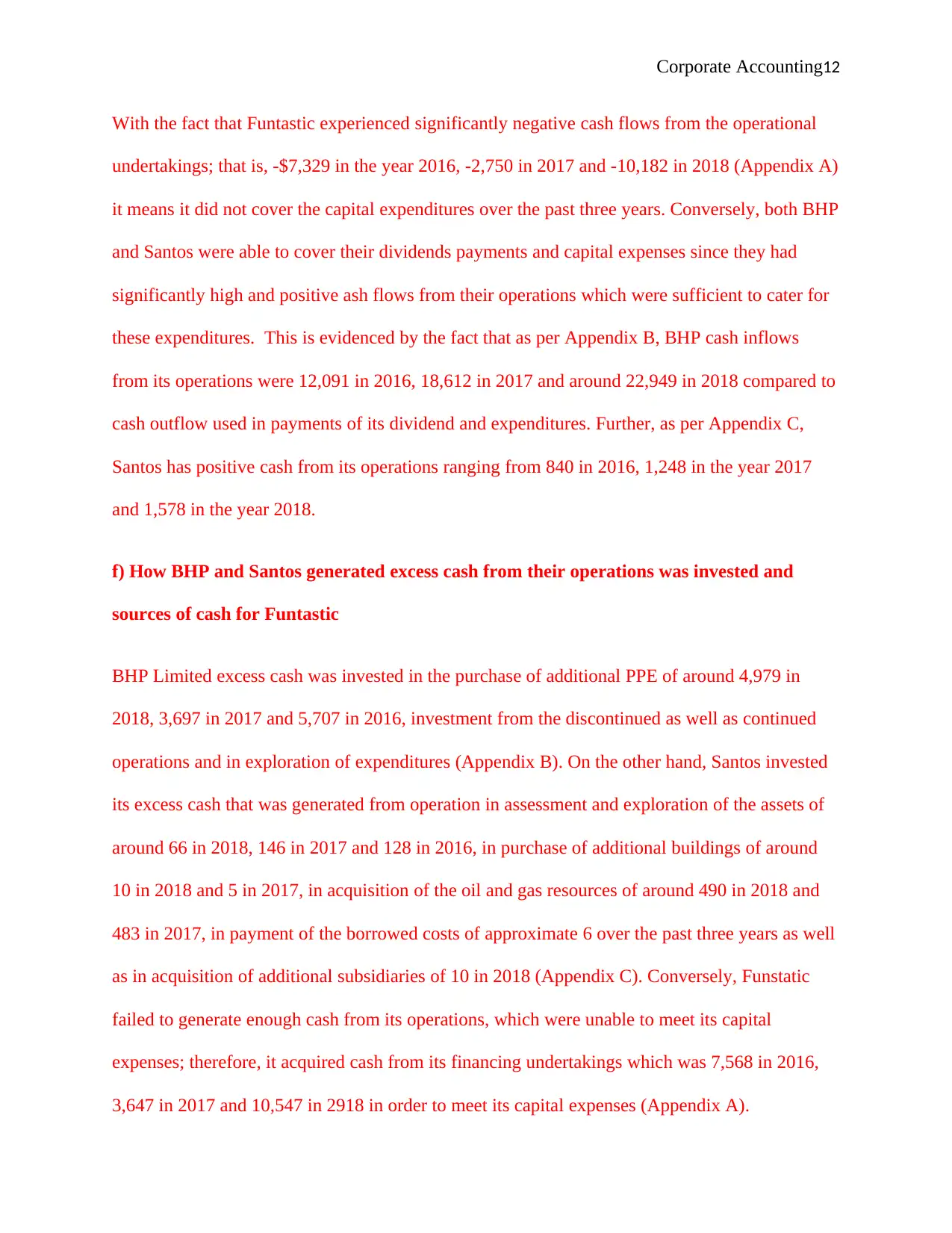
Corporate Accounting12
With the fact that Funtastic experienced significantly negative cash flows from the operational
undertakings; that is, -$7,329 in the year 2016, -2,750 in 2017 and -10,182 in 2018 (Appendix A)
it means it did not cover the capital expenditures over the past three years. Conversely, both BHP
and Santos were able to cover their dividends payments and capital expenses since they had
significantly high and positive ash flows from their operations which were sufficient to cater for
these expenditures. This is evidenced by the fact that as per Appendix B, BHP cash inflows
from its operations were 12,091 in 2016, 18,612 in 2017 and around 22,949 in 2018 compared to
cash outflow used in payments of its dividend and expenditures. Further, as per Appendix C,
Santos has positive cash from its operations ranging from 840 in 2016, 1,248 in the year 2017
and 1,578 in the year 2018.
f) How BHP and Santos generated excess cash from their operations was invested and
sources of cash for Funtastic
BHP Limited excess cash was invested in the purchase of additional PPE of around 4,979 in
2018, 3,697 in 2017 and 5,707 in 2016, investment from the discontinued as well as continued
operations and in exploration of expenditures (Appendix B). On the other hand, Santos invested
its excess cash that was generated from operation in assessment and exploration of the assets of
around 66 in 2018, 146 in 2017 and 128 in 2016, in purchase of additional buildings of around
10 in 2018 and 5 in 2017, in acquisition of the oil and gas resources of around 490 in 2018 and
483 in 2017, in payment of the borrowed costs of approximate 6 over the past three years as well
as in acquisition of additional subsidiaries of 10 in 2018 (Appendix C). Conversely, Funstatic
failed to generate enough cash from its operations, which were unable to meet its capital
expenses; therefore, it acquired cash from its financing undertakings which was 7,568 in 2016,
3,647 in 2017 and 10,547 in 2918 in order to meet its capital expenses (Appendix A).
With the fact that Funtastic experienced significantly negative cash flows from the operational
undertakings; that is, -$7,329 in the year 2016, -2,750 in 2017 and -10,182 in 2018 (Appendix A)
it means it did not cover the capital expenditures over the past three years. Conversely, both BHP
and Santos were able to cover their dividends payments and capital expenses since they had
significantly high and positive ash flows from their operations which were sufficient to cater for
these expenditures. This is evidenced by the fact that as per Appendix B, BHP cash inflows
from its operations were 12,091 in 2016, 18,612 in 2017 and around 22,949 in 2018 compared to
cash outflow used in payments of its dividend and expenditures. Further, as per Appendix C,
Santos has positive cash from its operations ranging from 840 in 2016, 1,248 in the year 2017
and 1,578 in the year 2018.
f) How BHP and Santos generated excess cash from their operations was invested and
sources of cash for Funtastic
BHP Limited excess cash was invested in the purchase of additional PPE of around 4,979 in
2018, 3,697 in 2017 and 5,707 in 2016, investment from the discontinued as well as continued
operations and in exploration of expenditures (Appendix B). On the other hand, Santos invested
its excess cash that was generated from operation in assessment and exploration of the assets of
around 66 in 2018, 146 in 2017 and 128 in 2016, in purchase of additional buildings of around
10 in 2018 and 5 in 2017, in acquisition of the oil and gas resources of around 490 in 2018 and
483 in 2017, in payment of the borrowed costs of approximate 6 over the past three years as well
as in acquisition of additional subsidiaries of 10 in 2018 (Appendix C). Conversely, Funstatic
failed to generate enough cash from its operations, which were unable to meet its capital
expenses; therefore, it acquired cash from its financing undertakings which was 7,568 in 2016,
3,647 in 2017 and 10,547 in 2918 in order to meet its capital expenses (Appendix A).
⊘ This is a preview!⊘
Do you want full access?
Subscribe today to unlock all pages.

Trusted by 1+ million students worldwide
1 out of 19
Related Documents
Your All-in-One AI-Powered Toolkit for Academic Success.
+13062052269
info@desklib.com
Available 24*7 on WhatsApp / Email
![[object Object]](/_next/static/media/star-bottom.7253800d.svg)
Unlock your academic potential
Copyright © 2020–2025 A2Z Services. All Rights Reserved. Developed and managed by ZUCOL.




